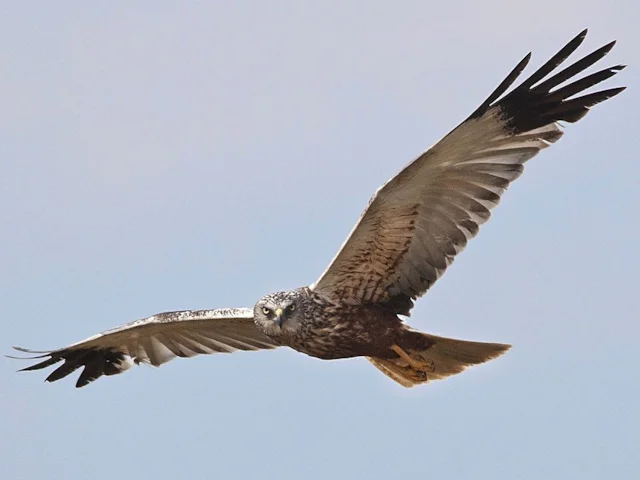Marsh Harrier returns to Poole Harbour
5e55d6dc-e997-476b-a74e-994035393e0d

After a 50-year absence, Marsh Harrier has bred again in Poole Harbour, adding to the healthy recovery of the species nationwide.
In the 1950s, Poole Harbour hosted 60 per cent of the entire British population of breeding Marsh Harriers, but by 1963 the species had gone, in parallel with the species' fortunes around the country as a whole. Now, after a 50-year absence, a pair of Marsh Harriers has finally decided to stay and breed in the reed beds around Wareham Channel, in the process doubling the Dorset breeding population to just two pairs.
Marsh Harrier was extinct as a breeding bird in Dorset until 2010, when a pioneer pair successfully raised young at Radipole Lake RSPB, Weymouth. Today, the only other pair in Dorset can be found at neighbouring Lodmoor RSPB.
It was believed that human disturbance, egg collecting, shooting and flooding were the main causes for their desertion of the county 50 years ago, with the prevalence of the pesticide DDT dealing the final blow. Though the species is still 'Amber listed' as a bird of conservation concern in Britain, with careful habitat management and better protection, it is making a remarkable come back across the whole country, with Dorset now following the trend.
Paul Morton from the Birds of Poole Harbour charity said: “This is spectacular news. We can have anything up to six Marsh Harrier in Poole Harbour during the winter, but these birds all head back to mainland Europe or further east in spring to breed. The fact a pair has finally decided to stay hopefully means others will follow suit in the coming years. The management of these habitats is crucial for species like this, and we can thank the likes of Natural England, the RSPB and the landowners, who put much time and effort into creating great habitats for a whole range of biodiversity.”
Landowner Ray Hegarty said: “I get great satisfaction from helping the wildlife on my land, and the arrival of these birds is a testament to the protection I’m trying to provide for all wildlife”
Dante Munns, RSPB Reserves manager for Dorset, added: “Poole Harbour is an internationally important habitat, but being so close to a major urban centre, it faces numerous pressures like disturbance from recreation, [artificial] nutrient enrichment and bait digging, not to mention the challenge of climate change and sea level rise. The fact that the harbour is still able to provide a home for an amazing wealth of wildlife, once again including Marsh Harrier, demonstrates the importance of protecting these special places”
Local harrier expert Peter Hadrill has been monitoring the nest site daily since mid-April, with the aim of writing a full analysis of the important event right until fledging. The resulting report will be available on the Birds of Poole Harbour website.
In the 1950s, Poole Harbour hosted 60 per cent of the entire British population of breeding Marsh Harriers, but by 1963 the species had gone, in parallel with the species' fortunes around the country as a whole. Now, after a 50-year absence, a pair of Marsh Harriers has finally decided to stay and breed in the reed beds around Wareham Channel, in the process doubling the Dorset breeding population to just two pairs.
Marsh Harrier was extinct as a breeding bird in Dorset until 2010, when a pioneer pair successfully raised young at Radipole Lake RSPB, Weymouth. Today, the only other pair in Dorset can be found at neighbouring Lodmoor RSPB.
It was believed that human disturbance, egg collecting, shooting and flooding were the main causes for their desertion of the county 50 years ago, with the prevalence of the pesticide DDT dealing the final blow. Though the species is still 'Amber listed' as a bird of conservation concern in Britain, with careful habitat management and better protection, it is making a remarkable come back across the whole country, with Dorset now following the trend.
Paul Morton from the Birds of Poole Harbour charity said: “This is spectacular news. We can have anything up to six Marsh Harrier in Poole Harbour during the winter, but these birds all head back to mainland Europe or further east in spring to breed. The fact a pair has finally decided to stay hopefully means others will follow suit in the coming years. The management of these habitats is crucial for species like this, and we can thank the likes of Natural England, the RSPB and the landowners, who put much time and effort into creating great habitats for a whole range of biodiversity.”
Landowner Ray Hegarty said: “I get great satisfaction from helping the wildlife on my land, and the arrival of these birds is a testament to the protection I’m trying to provide for all wildlife”
Dante Munns, RSPB Reserves manager for Dorset, added: “Poole Harbour is an internationally important habitat, but being so close to a major urban centre, it faces numerous pressures like disturbance from recreation, [artificial] nutrient enrichment and bait digging, not to mention the challenge of climate change and sea level rise. The fact that the harbour is still able to provide a home for an amazing wealth of wildlife, once again including Marsh Harrier, demonstrates the importance of protecting these special places”
Local harrier expert Peter Hadrill has been monitoring the nest site daily since mid-April, with the aim of writing a full analysis of the important event right until fledging. The resulting report will be available on the Birds of Poole Harbour website.

